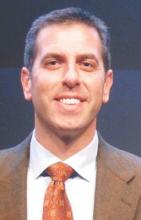WASHINGTON – Physicians have a role in combating early childhood obesity, but experts say the clinical setting is not ideal for effective treatment and prevention of this emerging epidemic.
“Pediatricians have high access to kids, parents, and guardians, and we are trusted sources of information for them,” Dr. Ian Paul, professor and chief of academic pediatrics at Penn State University Hershey Medical Center, said at an Institute of Medicine forum on early childhood obesity.
Emerging data underscore obesity’s complex societal components, which include an imbalance of diet and physical activity complicated by less tangible factors such as cultural attitudes, maternal habits, and socio-economic status. And then there is the question of the best way to reimburse physicians for applying the few proven long-term interventions they have.
“I think it’s one of those things where it takes a village,” Dr. Paul said in an interview. “You need multiple people going in the same direction. The pediatrician can give advice, and support what is happening, but it can’t just be the pediatrician by him- or herself.”
The U.S. Centers for Disease Control and Prevention says that pediatric obesity affects a third of the nation’s youth. But there are only vague policies and guidelines for how to intervene in the preschool years, a time when research now shows risk factors present can set the stage for obesity later in a child’s life. This all leaves pediatricians unsure of how to treat young patients who present with signs of overweight and obesity. To date, there are no proven clinical-based obesity interventions for birth to age 5 years, Dr. Paul said. “Pediatricians don’t always feel equipped to handle questions about obesity prevention and treatment,” compounded, by the fact that, “reimbursement for these services has been poor.”
However, through partnerships with community organizations and other clinicians, more effective models of care are emerging, particularly in minority and lower income communities where obesity rates are among the highest nationally (Contemp Clin Trials. 2013 Nov;36[3]:544-54. doi: 10.1016/j.cct.2013.09.015. Epub 2013 Oct 9), noted Dr. Paul.
“In poorer households, high rates of maternal stress and less access to resources such as time with a nutritionist or higher quality produce and other foods, are risk factors for obesity,” Dr. Mary Jo Messito, director of the Starting Early Child Obesity Prevention Program at Bellevue Hospital in New York, said in an interview.
As part of their program, Dr. Messito, clinical associate professor of pediatrics at New York University, and her colleagues conducted a study of a family-based, early obesity intervention and prevention program with nutrition support groups as the central component.
The study involved 534 expectant mothers in their last trimester who were randomly assigned to receive either standard prenatal care followed by standard well-child care, or prenatal nutritional counseling, in addition to well-child visits coupled with continued nutritional counseling in a group setting, which they attend with their babies. The study group met regularly to learn how to make their own minimally processed baby foods, read and understand food labels, and offer peer support for any issues they might be encountering in raising their babies to eat healthfully.
Although many Hispanic families are affected by obesity, there is a need to teach and reinforce these skills in all families of young children affected by poverty, said Dr. Messito. “Middle and upper income people can also be affected by obesity, but they have the resources to deal with it, including education and nutritional support provided by insurance plans.”
The currently unpublished results of the study, based on 3 years of follow-up, are both statistically and clinically significant, said Dr. Messito. Only 6% of the families in the study group prematurely introduced complementary foods such as juices and solids compared with 17% in controls, according to Dr. Messito.
Exclusively breastfed babies in the control group totaled 34% compared with an impressive 46% in the study group, Dr. Messito said.
The potentially devastating consequences of resorting to quick-fixes such as cereal and juice at too young an age to sooth a fussy baby, is that at age 2 or 3 years, when it is still tricky to determine if they’ve exceeded the 95th percentile for their weight, these overfed babies can be on a trajectory that lasts long after they grow up. “If you are obese then, the odds are great you will be for life,” said Dr. Messito.
Much of the Starting Early study’s “plain language” materials, published in both English and Spanish, distributed to families as reinforcement to what they learn in their groups, was based on what is routinely provided by the federal Women, Infants, and Children (WIC) program, said Dr. Messito. “We see ourselves as collaborators with WIC and with primary care.”


